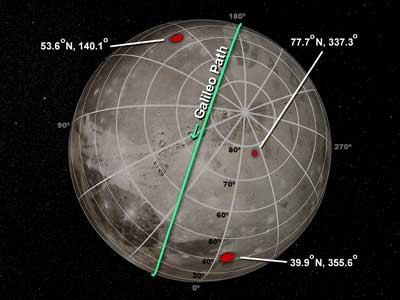Scientists used data from NASA's Galileo spacecraft to uncover strange rocky masses beneath Ganymede's ice mantle. One theory claims that they are rock structures that are stuck deep in the ice and held that way for billions of years
By: Ariel Eisenhandler, Israel Astronomical Society

Scientists used data from NASA's Galileo spacecraft to uncover strange rocky masses beneath Ganymede's ice mantle. One theory claims that they are rock structures that are stuck deep in the ice and held that way for billions of years. The data was collected by Galileo during its second flyby of the Moon in 1996. The discovery challenges theories about the thickness and strength of Ganymede's ice - we would expect the rocks to be held up or resting down, but they are somewhere in between. Galileo was fired on Jupiter almost a year ago (and this was for fear that it would contaminate Europa, another Galilean moon of Jupiter, which is believed to have life conditions for some kind of life on it).
Scientists have discovered unusual lumps under the ice cover of Jupiter's largest moon - Ganymede. These unusual masses could be rock structures, supported by Ganymede's ice shell for billions of years. The discovery comes almost a year after the "transfer of ownership" of NASA's Galileo spacecraft to Jupiter's atmosphere, and hence its "death" in a crash, and seven years after the data collection. Researchers at the Jet Propulsion Laboratory (JPL) in Pasadena, California and the University of California, Los Angeles report their findings in an article to be published in the 13th edition of the "Journal Science" in August.
The findings have caused scientists to rethink what Ganymede's interior contains. The reported bumps lie in the interior of the moon, and there are no visible markers on the surface connecting them. This tells scientists that the ice is probably strong enough, at least near the surface, to support these possible rock masses from sinking to the ice floor over billions of years. If this is indeed a deviation, it may be caused by rock accumulations at the bottom of the ice.
"The anomalies could be concentrations of rock at or below the ice surface, or a layer of ice and rock mixed with varying amounts of rock," says Dr. John Anderson, a scientist and lead author of the JPL paper. "If there is a liquid water ocean in Ganymede's outer ice layer, there may be changes in its depth with rock accumulations at the bottom of this ocean. There may be topographic changes in a hidden rocky surface, which lies beneath a deep, outer ice sheet. There are many possibilities and we must examine the issue in more detail."
Dr. Gerald Schubert, co-author of the paper at UCLA (University of California, Los Angeles) says, "Although at this point we still don't have anything definitive about the depth, we didn't expect that the ice sheet of Ganymede would be powerful enough to support these clumpy mass concentrations. We therefore expect the anomalies to be near the surface where the ice is coldest and strongest or at the bottom of the thick ice sheet, underlain by bedrock. It would be extremely surprising if these masses were deep and in the middle of the ice sheet."
Ganymede has three main layers: a ball of metallic iron in the center (the core), a spherical shell of rock (outer shield) that surrounds the core, and an outer shell composed mostly of ice that surrounds the rock shell and core. The ice cover in its outer part is very thick: about 800 km. The surface is the highest part of the ice sheet. Although most of it is composed of ice, the ice shell may contain rocks within it. Scientists believe that there is a considerable amount of rocks in the ice, close to the surface. Deviations in the amount of rocks can be the source of the possible rocky structure. The scientists came across the results by examining Doppler measurements of Ganymede's gravity field during Galileo's second flyby of the moon in 1996. They measured the effect of the moon's gravity on the spacecraft during its passage by it. They found unexpected anomalies. "Believe it or not, it took us so long to fix the aberration problem, mainly because we analyzed all 31 of Galileo's close passes by Jupiter's four big moons," says Anderson. "In the end we concluded that there is only one transition, the other one near Ganymede, where the mass deviations are noticeable."
Scientists have already seen anomalies in the mass concentrations on one moon in the past, the moon of KDHA, during the first lunar orbit mission in the 60s. The mass concentrations on the Moon during the era of the Apollo missions are the result of lava in flat craters. Despite this, the scientists do not find similarities between the concentrations of these masses and those observed on Ganymede.
"The fact that these mass deviations can be detected by no more than a passage of a spacecraft near the moon is significant for future missions," says Dr. Torrence Johnson, a former Galileo project scientist. "This type of information enables detailed mapping of gravity and height, which in turn enables mapping of structures within the ice crust or on the rocky surface. Additional information about Ganymede's interior raises the level of importance of the search for gravitational anomalies around Jupiter's moons and gives something to look forward to in the future."
A future mission proposed by NASA, the coffee mission around Jupiter's icy moons, could investigate the issue in depth (literally).
The article was authored by co-authors including Dr. Robert A. Jacobson (Robert A. Jacobson) and Eunice L. Lau (Eunice L. Lau) from JPL as well as Dr. William B. Moore (William B. Moore) and Jennifer L. Palguta (Jennifer L. Palguta) from UCLA.
JPL is a department of the California Institute of Technology in Pasadena. JPL designed and built the Galileo orbiter and they operate the mission.
